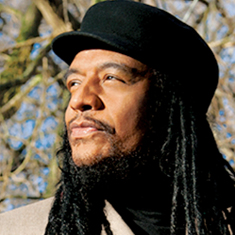Christened the “King of Lovers Rock” by his fans, British reggae star Maxi Priest was one of the most internationally popular reggae singers since Bob Marley. Priest’s pop and modern R&B influences didn’t exactly endear him to reggae purists, but they gave him a strong crossover appeal that paid off in the trans-Atlantic chart-topper “Close to You.” At times he strayed too far from his reggae roots to deliver a true stylistic hybrid, but his silky-smooth voice was ideally suited for light, romantic material, and his best music was as sensual as it was soulful. Priest was born Max Elliott on June 10, 1962, in the Lewisham area of London. He was the eighth of nine children, born to parents who had emigrated from Jamaica several years before his birth. His mother was active in the Pentecostal church, and the family grew up singing gospel music together; Maxi would later convert to Rastafarianism, upon which point he changed his name to Maxi Priest.
He was working as a carpenter when he was invited to build speaker boxes for the prominent Saxon International sound system. It wasn’t long before his contacts there discovered that he could sing as well, and soon he was participating in live dancehall shows; in 1984, he and Paul “Barry Boom” Robinson also co-produced Phillip Levi’s “Mi God Mi King,” the first U.K.-born reggae single to hit number one in Jamaica. Priest signed with Virgin Records and released his debut album, You’re Safe, in 1985. A more traditional reggae set than his subsequent releases, it featured production by Robinson and live instrumental backing from the band Caution, and spun off the U.K. hit “In the Springtime.” His 1986 follow-up, Intentions, featured two more U.K. successes in “Strollin’ On” and the Van Morrison cover “Crazy Love.” However, it was 1988’s Sly & Robbie-produced Maxi Priest that ranked as his true breakthrough; his Top 30 cover of Cat Stevens’ “Wild World” gave him his first American hit, and another cover, Robert Palmer’s “Some Guys Have All the Luck,” kept his hit streak alive in the U.K. Elsewhere, he embraced slinky lovers rock grooves to a greater extent than ever before, and even made a rare detour into social consciousness with the Beres Hammond duet “How Can We Ease the Pain?”
Now hugely popular in the U.K., and on his way in the U.S., Priest recorded what would become his biggest-selling album, Bonafide. Released in 1990, it climbed up the charts by virtue of the steamy, Soul II Soul-influenced single “Close to You,” which went all the way to number one on the American pop charts. Follow-ups “Just a Little Bit Longer” and “Space in My Heart” failed to duplicate its success Stateside, although “Peace Throughout the World” and “Human Work of Art” were both popular in Britain. The hits collection Best of Me was rushed out in 1991, not long after Priest teamed with Shabba Ranks for the dance-club hit “House Call,” and not long before another Priest duet, the Roberta Flack collaboration “Set the Night to Music,” climbed into the U.S. Top Ten. Nonetheless, Priest’s next album, 1992’s Fe Real, was a solid outing but a commercial disappointment; neither of the American singles, “Groovin’ in the Midnight” or the Shaggy duet “One More Chance,” made much of an impact either. After a supporting role in the movie Scam, Priest took a sabbatical from recording for a few years to concentrate on launching his own U.K. label, Dugout. Priest returned in 1996 with Man With the Fun, the most crossover-oriented album in his catalog to date. It spun off a U.S. and U.K. Top 20 hit in “That Girl,” another duet with Shaggy. Despite its dancehall flavor, much of the album found Priest moving away from the lovers rock that had made his name. That trend continued on 1999’s CombiNation, which focused predominantly on hip-hop and smooth soul balladry.
Source: All Music Guide

